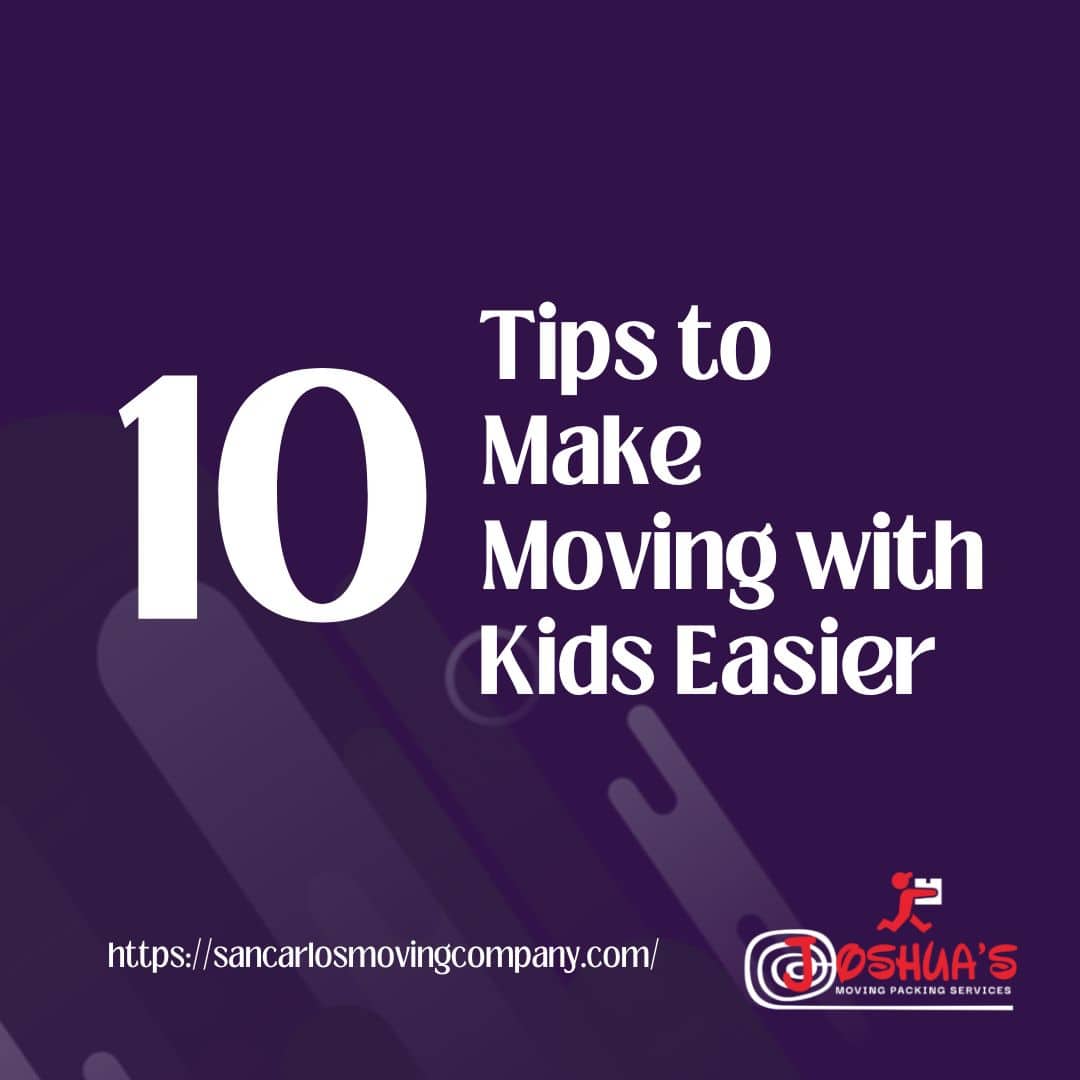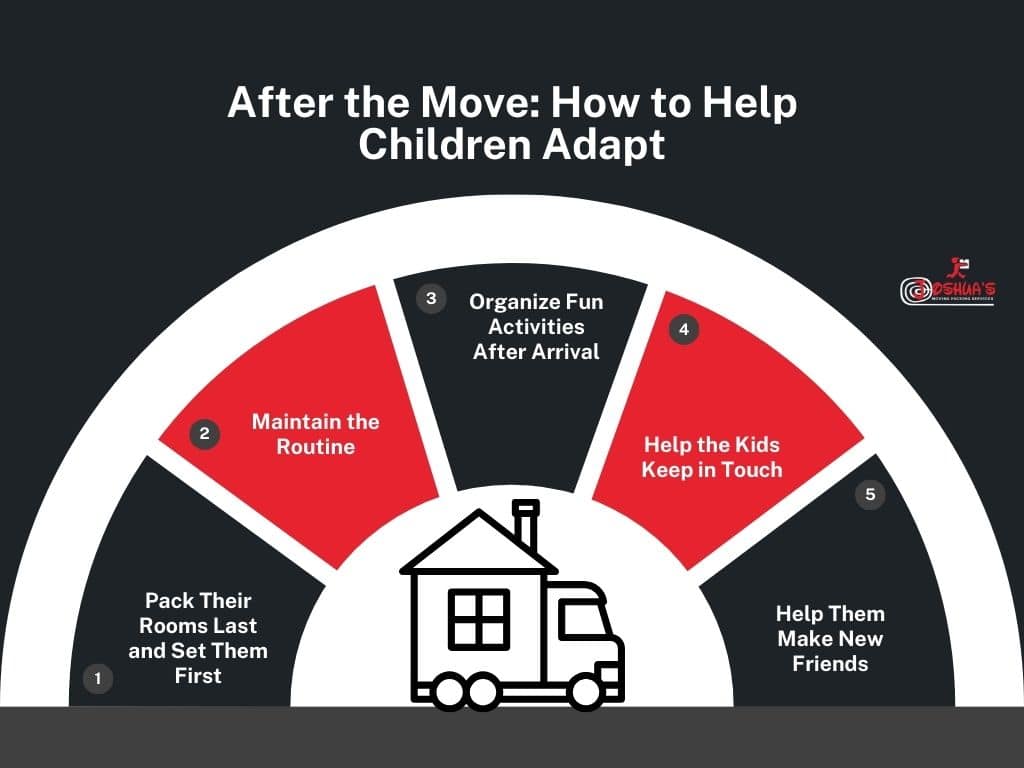Whether we are talking about moving with teens, toddlers, or tweens, it can be emotionally destabilizing and physically draining to the kids. From detaching from their beloved bedroom, saying goodbye to friends, and transitioning to…

Tips to Make Moving with Kids Easier
April 26, 2024
Uncategorized
Whether we are talking about moving with teens, toddlers, or tweens, it can be emotionally destabilizing and physically draining to the kids. From detaching from their beloved bedroom, saying goodbye to friends, and transitioning to a new school, kids need assistance adapting to these changes.
I remember the first relocation as a family; everyone considered it any other move. What followed was a series of surprises, and from that experience came several lessons that I can share to make moving with kids less stressful.
This blog post digs deep into:
- How to Prepare for the Move
- Tips to Make the Moving Day Easier
- After the Move: How to Help Kids Adapt
- Tips to Involve Children in the Moving Process
How to Prepare for the Move
Kids can easily accommodate new environments more than we imagine, but only if prepared well. Preparation includes letting your toddlers know they will move their toys, listening to your teenagers, and validating their feelings. Let’s dig deeper into how you can prepare to move with children.

1. Be Honest
The fears, anxieties, worries, and frustrations of moving can melt away if you explain what is happening to your kids. Whether you got a new job or you want a spacious house, let the children know the reason for moving. Even if the reasons are less favorable, like eviction, it is essential to disclose the situation to children who can understand it.
Apart from disclosure, you should bring out the positives of the relocation. Some of the ideas that can help you include:
- Presenting the move as an opportunity to explore a new environment
- Letting the children know real friendship goes beyond distance
- Showing the possibility of making new friends
As an adult, you have your worries and anxieties, which you should avoid projecting on the kids. Kids will likely feel more anxious if you show them that you feel helpless about the situation.
Because toddlers thrive in structures and routines, assure them that they will move with their toys, retain their favorite beddings, and reconnect with other family members. Also, disclose when you will be moving, how the move will impact the family, and how they can prepare. Of course, this should be done in age-appropriate language.
2. Visit the New Home Together
Kids have a sixth sense and can tell a new environment, even in sleep.
For teens, it is essential to take them along in your search for a house and let them share what they like about each, without promising anything. But let them know that their opinions are important in the decision-making. You can also take them to the local hangout places like pizza shops and parks.
Because toddlers might not understand the complexities of relocation, you should go to their level to make them associate moving with fun. Take them to the local ice cream shop, let them interact with kids in the nearby park, and visit the daycare if you have already chosen one.
If the distance is prohibitive, you can take a virtual tour of the neighborhood through Google Earth. In the selection process, you can present the images of the houses and let the children give you feedback. Sometimes, they can pinpoint a detail you had ignored or not seen and help you break a tie.
3. Host a Moving Party
Goodbyes are the hardest things to say to people and places that mean something to you. And it is no different with kids. If the place you are leaving is all they have known all their life, it is good to appreciate it won’t be easy for them. But you can make the transition a little smoother by hosting a moving party.
Allow the children to say goodbye to their friends and favorite rooms. If you are planning to go back to visit friends, let the kids know that the goodbyes don’t mean forever. This gives them something to look forward to as they adapt to the new environment. Moving for kids shouldn’t feel like they are being relocated to another planet.
Let the children be part of the moving party plans by allowing them to choose the décor and invitees. You can also keep memories by taking photos outside the house, in the rooms, and other favorite spaces. These celebrations ease the tension of leaving a familiar home for a new one.
Tips to Make the Moving Day Easier
Where do you start on the moving day? If you have involved the kids in the relocation planning process, you will have an easier time on D-day. Here are some ideas to make the day less stressful:
4. Introduce Your Kids to the Movers

Hiring a moving company if you have kids requires a strategic approach to ease the tension of strangers in your space. A simple gesture like introducing your kids and movers to each other can ease the moving process.
Let the children hold doors open for the movers or assist in carrying lightweight items to give them a sense of involvement and responsibility. They can also take drinking water to the team to keep them hydrated. This makes the move a collaborative effort for the whole family.
5. Hire a Babysitter or Nanny for Toddlers
Imagine dealing with toddlers when you have packed their cot and other essentials. Also, the noise of packing, dragging furniture and amplifying your voice to the team downstairs. All these can be stressful to toddlers and even adults.
So, if you can get a babysitter on the moving day, it will help manage the tension. They can also stay with their favorite neighbors, which is a good opportunity to spend more time with friends they will not see often.
There are also the hazards that come with relocation. Whether it is kids hiding along the loading path or getting underfoot, having a babysitter or nanny present can ensure that the toddlers are safe and occupied. This allows you to focus on the move and run miscellaneous tasks like placing requests for more moving boxes.
After the Move: How to Help Children Adapt
Most experts agree that it takes one to two months for kids to settle in a new environment. Within this period, you will likely observe a change in attitude, behavior, and mood, especially in teens. But how can you make the process easier and faster?

6. Pack Their Rooms Last and Set Them First
Minimal disruption is the rule here. Packing the kid’s room last prevents distractions too early before everything is loaded. They can still enjoy more time with their favorite toys or books, maintaining comfort and familiarity amidst the moving chaos.
When unloading, their items will be in a strategic place to set up their bedrooms first. This approach ensures continuity and less stress adapting to the new environment. The children will also have familiar toys to play with as you set up the other rooms.
7. Maintain the Routine
Keep the routine to ease the transition even a few days towards the day of the move. Remain consistent in napping, bedtime, and homework schedules before and after the move. Children should feel reassured that a move doesn’t mean turning their world upside down.
After settling, picking up the positive habits you had created in the previous house is essential. It could be bedtime stories, watching a movie on Sunday evenings, or sharing a pizza on Friday nights. These routines mean a lot to children; maintaining them will help them settle faster.
If any adjustments need to be made, explain them to the kids. In short, you should involve the children in settling in to show that you care about them.
8. Organize Fun Activities After Arrival
What will the first day in the house look like? It is good to have things figured out to avoid the anxiety of a new environment. First, you can ensure you share your favorite meal as a family. If you will not have set up the kitchen, which is more likely, find a good restaurant to dine in or order.
Second, you can make the day fun by playing a game together after the unpacking. Help the children relate the new space to an enjoyable time together as a family.
9. Help the Kids Keep in Touch
Detaching from friends and classmates is not the easiest thing to do. You can show your children that you understand their feelings by offering your phone so they can update their friends about the new house and neighborhood.
Although children make new friends as the focus shifts to the new environment, it is good to appreciate that this won’t happen in a day. Gradual transitioning and honoring their lost friendship helps them to settle down academically, socially, and emotionally.
10. Help Them Make New Friends
If you are relocating to a friendly neighborhood, it doesn’t hurt to say hi to those around you and introduce yourself and the kids. This makes the children feel at ease as they interact with new friends and facilitates faster friendships.
Joining a local club will also give your children an easier time to adapt as they interact with their peers. If your children are into a particular sport, look for playgrounds that accommodate such activities. Also, introduce them to their new coach and other players and observe how they adapt to the team.
You can go the extra mile and volunteer in local non-profits to build relationships faster. It could be volunteering at the school, participating in community events, or joining parent-teacher associations. Your connections mean more relationships for your children in the new community.
Tips to Involve Children in the Moving Process
- Consider their views on the move: Although you don’t have to promise anything, listening to your children’s views can help you know how to support them in the new locality.
- Allow them to create a checklist: As you plan how to pack, load, and unload their rooms, allow the kids to be part of the plan. Give them a book to create and tick a checklist of things they want to carry or donate.
- Let them Help with the boxes: Allow your kids to carry the small boxes and feel the excitement of relocation. However, ensure they don’t overdo and have a stressful time in the new house.
- Allow them to choose their room décor: Teenagers and tweens will be glad to make choices about their new spaces. You can guide them to make the right choice depending on your theme.
Conclusion
Just like it is not easy for adults to adapt to a new environment after moving, it is the case for kids. However, how you approach the process can determine how easy or stressful the relocation is. So, depending on the age of the children, involve them from the initial stage of choosing a new home.
Joshua’s Moving Packing & Storage can make your relocation with kids enjoyable. We have a team of children-friendly and professional movers to assist you. Get in touch with us today and say goodbye to the anxieties of transitioning to your new home.

